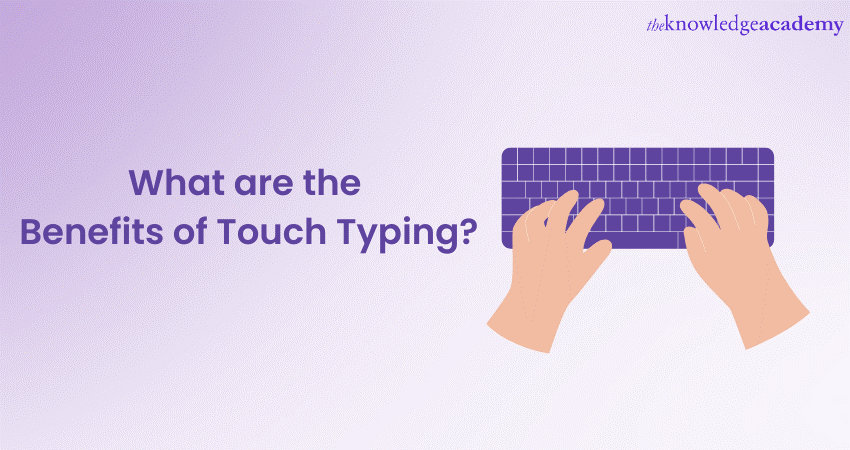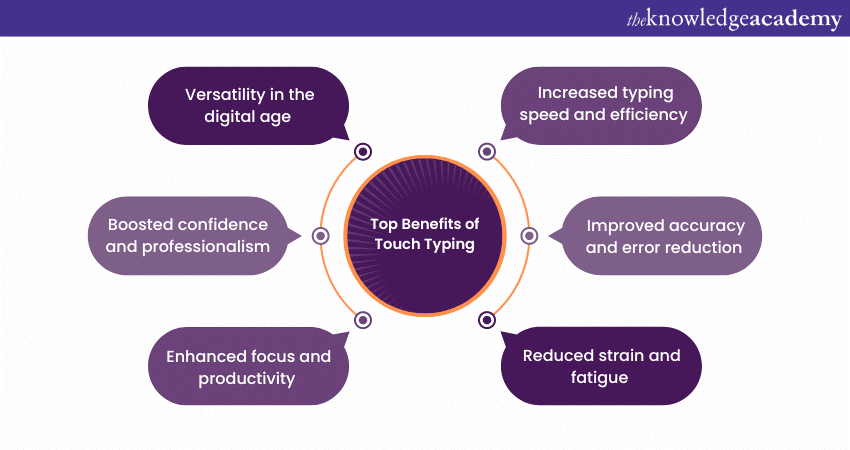We may not have the course you’re looking for. If you enquire or give us a call on 01344203999 and speak to our training experts, we may still be able to help with your training requirements.
Training Outcomes Within Your Budget!
We ensure quality, budget-alignment, and timely delivery by our expert instructors.

In today's fast-paced digital world, proficient typing skills have become an invaluable asset, both personally and professionally. One of the most effective and sought-after typing techniques is Touch Typing. The Benefits of Touch Typing extend far beyond mere convenience.
So, regardless of whether you're a student, a professional, or simply someone looking to boost their computer literacy, understanding the perks of Touch Typing is a crucial step towards optimising your digital efficiency and comfort. In this blog, you will understand the top Benefits of Touch Typing along with the associated intricacies. Read more to learn!
Table of Contents
1) Top Benefits of Touch Typing
a) Increased typing speed and efficiency
b) Improved accuracy and error reduction
c) Reduced strain and fatigue
d) Enhanced focus and productivity
e) Boosted confidence and professionalism
f) Versatility in the digital age
2) Conclusion
Top Benefits of Touch Typing
From improved accuracy to reduced strain, the Benefits of Touch Typing are invaluable for individuals across various professions and walks of life. Some of the top Benefits of Touch Typing are as follows:

Increased typing speed and efficiency
One of the many Benefits of Touch Typing includes its dependency on muscle memory. The fingers instinctively know the location of each key without the need for visual cues. This enables typists to type at significantly higher speeds compared to traditional methods. With practice, Touch Typists can achieve speeds of 60-80 words per minute or even higher.
This newfound efficiency is invaluable in a wide range of scenarios, from drafting emails to coding complex algorithms. As typing becomes second nature, the cognitive load associated with finding keys is drastically reduced, allowing for seamless and uninterrupted workflow.
Moreover, Touch Typing liberates the typist from the constraints of looking at the keyboard. With fingers resting on the home row and each assigned to a specific set of keys, Touch Typists can type effortlessly without the need for constant visual verification. This allows for an uninterrupted flow of thought, as ideas can be transcribed directly from the mind to the screen.
The absence of frequent pauses to locate keys not only accelerates typing speed but also ensures that the creative or analytical process remains undisturbed. This seamless flow of ideas leads to higher quality work in less time, ultimately boosting overall productivity.
Ready to revolutionise your typing efficiency? Register for our Touch Typing Training now for a seamless and productive digital experience!
Improved accuracy and error reduction
Touch Typing, with its emphasis on muscle memory and finger placement, leads to a substantial improvement in typing accuracy. Unlike the hunt-and-peck method, where the typist often has to visually locate keys, Touch Typists rely on a trained sense of touch to hit the right keys. This minimises the occurrence of typing errors, resulting in a more polished final product.
Additionally, Touch Typing encourages a disciplined approach to keystrokes. The typist's fingers naturally gravitate towards the designated keys for each letter, reducing the likelihood of pressing neighbouring keys by mistake. This precision is particularly crucial in professions that demand meticulous attention to detail, such as transcription services, data entry, and coding.
Reduced strain and fatigue
Touch Typing promotes a more ergonomic typing posture, significantly reducing strain and fatigue on the hands, wrists, and fingers. By keeping the fingers on the home row and utilising all ten digits, typists can achieve a more natural and comfortable hand position. This minimises the risk of developing repetitive strain injuries associated with prolonged keyboard use. The reduction in physical discomfort allows individuals to type for longer durations without experiencing the usual levels of fatigue, making Touch Typing an essential skill for professionals who rely heavily on keyboards in their work.
Enhanced focus and productivity
With Touch Typing, the typist's attention shifts from finding keys to the content being typed. This leads to a heightened focus, enabling individuals to concentrate more effectively on the task at hand. The streamlined typing process, without constant visual verification, allows a more immersive work experience. This enhanced concentration directly translates to higher productivity levels, as tasks can be completed efficiently and with fewer interruptions.
Boosted confidence and professionalism
Mastering Touch Typing instils a sense of confidence in one's typing abilities. This newfound proficiency allows individuals to approach tasks involving typing with assurance and competence. In professional settings, where fast and accurate typing is often expected, Touch Typing sets individuals apart as capable and proficient.
It conveys a sense of professionalism, reinforcing the notion that the typist is in full control of their tools and can deliver high-quality work consistently. This boost in confidence can positively impact on overall job performance and career prospects.
Versatility in the digital age
Touch Typing is a skill that transcends professions. It is invaluable for students, professionals, writers, coders, and anyone who interacts with a keyboard regularly. With the prevalence of digital communication and documentation, Touch Typing is a fundamental skill that opens up a world of opportunities in various fields. From creating reports to coding complex algorithms, its versatility is indispensable in navigating the demands of the modern digital landscape.
Improved multitasking
Touch Typing is a game-changer when it comes to multitasking. Unlike traditional typing methods that often require visual confirmation of each keystroke, Touch Typing allows individuals to type seamlessly without constantly diverting their attention to the keyboard. Fingers are intuitively positioned on the home row, ensuring that typing can be done without breaking focus on the screen.
This enhanced multitasking ability is invaluable in a variety of scenarios. For instance, professionals engaged in activities like live transcription, coding, or data entry can significantly benefit. They can maintain a steady workflow while simultaneously referring to source material, code snippets, or data sheets without missing a beat. This efficiency is not only a time-saver but also minimises the risk of errors that can occur when attention is divided between the task at hand and keyboard navigation.
Conclusion
There are several Benefits of Touch Typing that contribute to a more seamless and comfortable typing experience, from reduced strain to enhanced focus. Therefore, it has become an indispensable skill in today's fast-paced digital world, empowering individuals across professions and endeavours.
Ready to elevate your PA and Secretarial skills? Explore our comprehensive PA and Secretarial Training and embark on a journey towards excellence!
Frequently Asked Questions
Upcoming Business Skills Resources Batches & Dates
Date
 Minute Taking Training
Minute Taking Training
Fri 9th Aug 2024
Fri 6th Sep 2024
Fri 4th Oct 2024
Fri 8th Nov 2024
Fri 6th Dec 2024
Fri 3rd Jan 2025
Fri 7th Mar 2025
Fri 2nd May 2025
Fri 4th Jul 2025
Fri 5th Sep 2025
Fri 7th Nov 2025







 Top Rated Course
Top Rated Course



 If you wish to make any changes to your course, please
If you wish to make any changes to your course, please


